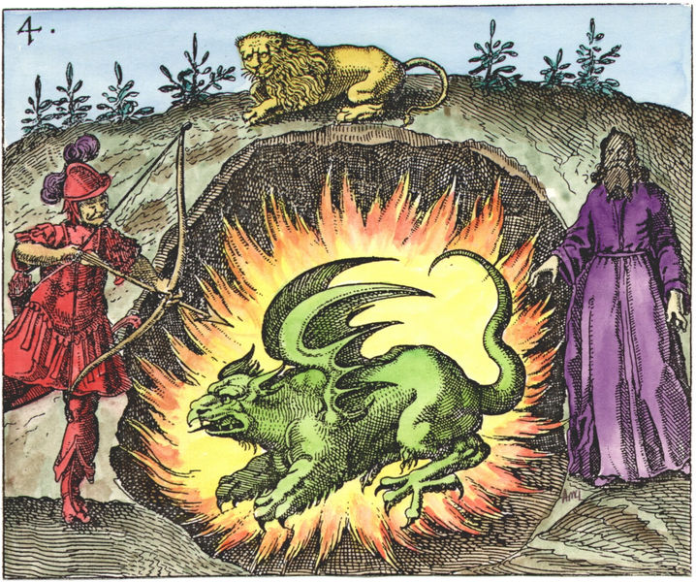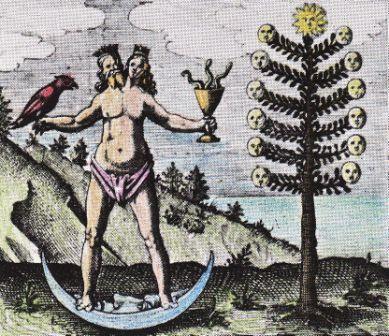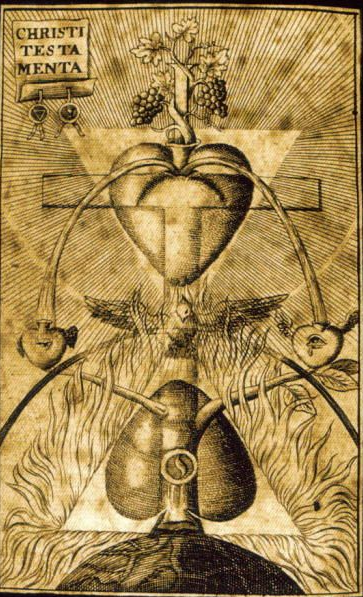Ancient Psychedelia: Alien Gods & Mushroom Goddesses
Online Book - Chapter 20, Page 402
Back to Online Book Mainpage / Next Page (Chapter 20, Page 403)
In the Philosophia Reformata by Johann Daniel Mylius (1622) there are a number of alchemical depictions which reveal pictorially the entire alchemical sequence. One image depicts a dragon under the dirt, with an archer pointing his bow and arrow at it (74e). We can see Hermes with his medical caduceus staff. Another image depicts what appears to be an “alchemical wedding” of two lovers. Afterwards, the two are united as the hermaphrodite. The male king half is holding a bird in his hand and the female queen half is holding a cup with three serpent heads popping out.  (74e) Philosophia Reformata 1622 Jakob Bohme (1575-1624 AD) was a German philosopher, a Christian Gnostic mystic and alchemist during the peak of the Renaissance when the “enlightenment” was taking full hold of Europe and created a drawing entitled “The Chresti Testamenta,” which displays a mushroom in the middle of a heart, as part of the central theme, though it is not obvious to the untrained eye at first glance (74d). The trained eye will actually see two mushrooms. |
 (74d) Christi Testamenta' by Jakob Böhme c. 1500-1600 Bohme, in The Way to Christ, writes in a way which sounds familiar to many people high on psychedelic substances: “When thou art gone forth wholly from the creature [human], and art become nothing to all that is nature and creature, then thou art in that eternal one, which is God himself, and then thou shalt perceive and feel the highest virtue of love. Also, that I said whosoever findeth it findeth nothing and all things; that is also true, for he findeth a supernatural, supersensual Abyss, having no ground, where there is no place to dwell in; and he findeth also nothing that is like it, and therefore it may be compared to nothing, for it is deeper than anything, and is as nothing to all things, for it is not comprehensible; and because it is nothing, it is free from all things, and it is that only Good, which a man cannot express or utter what it is. But that I lastly said, he that findeth it, findeth all things, is also true; it hath been the beginning of all things, and it ruleth all things. If thou findest it, thou comest into that ground from whence all things proceed, and wherein they subsist, and thou art in it a king over all the works of God.” (22) Corpus Hermeticum, generally refers to Marsilio Ficino's Latin translation in fourteen tracts. The first eight of which appeared before 1500 and another twenty-two by 1641. We may see this as yet another allegorical alchemy tract which teaches the internal process, by which the adept or initiate climbs the ladder to higher functions of their own soul. The formula is given in an example of a tincture or elixir, considered to be a great treasure, consisting of both red and white principles, utilizing the properties of sulphur and mercury to create a “true son.” (22) Apples of Apollo, p. 181; Jakob Böhme "The Way to Christ", 1623 |
Go Back to Page 401